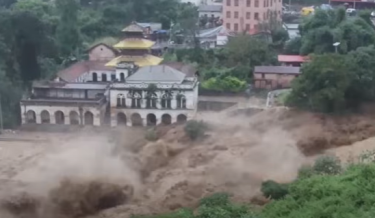
Nepal is reeling from the aftermath of catastrophic floods and landslides that have claimed at least 224 lives, with 24 people still missing and 158 injured. The disaster, triggered by incessant monsoon rains that began on 26 September, has affected 44 of Nepal's 77 districts, causing widespread destruction and displacing thousands.
The capital city, Kathmandu, bore the brunt of the calamity, witnessing the most intense rainfall in over half a century. The Bagmati River, which runs through the city, breached its banks, inundating entire neighbourhoods and causing extensive damage to infrastructure.
Chief Secretary Ek Narayan Aryal reported at a press conference that the damages are estimated at over 17 billion Nepali Rupees (approximately USD 127 million). Prime Minister K. P. Sharma Oli announced that search and rescue operations, involving 30,700 security personnel, would conclude within two days, with over 4,000 victims already rescued.
The government has declared a three-day national mourning period, which began on Tuesday, with national flags lowered to half-mast. Prime Minister Oli admitted that the government had not foreseen the extent of devastation caused by the continuous rains that hit the region on Friday and Saturday.
The disaster has disproportionately affected the poorest residents of Kathmandu, many of whom live in informal settlements along the riverbanks. Man Kumar Rana Magar, a 49-year-old slum resident, criticised the government's response, saying, "We are so close to the seat of the government. If they cannot take care of the poor this close, what will they do about others?"
The floods have also impacted remote areas, with many villages still awaiting relief efforts. Mira KC, a resident of Kavre district east of Kathmandu, told the media, “There is no road, so no one has come. Even if they do, those who died are dead already and the damage is done. All they will do is offer condolences, what will they do?”
The disaster has caused significant damage to infrastructure, with hundreds of houses, schools, and hospitals affected. Bridges and roads have been swept away, and powerlines and telecommunication networks disrupted. At least 20 hydropower plants with a combined capacity of 1100 MW have suffered damages, leading to power supply disruptions in Kathmandu and other major cities.
The floods have also raised concerns about food and water security. With water pumps, pipes, and cropland damaged, access to safe drinking water and food could become a major challenge in the coming days. Market prices have soared as vegetable supplies from India and other districts have been temporarily halted due to obstructed highways.
The United Nations and its partners have mobilised rapidly to deliver aid and assess the damage. UNICEF has set up a medical tent to temporarily replace a major hospital that was destroyed, potentially reaching 2,000 people with healthcare. The agency is also distributing vital supplies, including hygiene kits, water purification tablets, blankets, and mosquito nets.
Florine Bos, Chief of Communications at UNICEF Nepal, expressed concern for children's wellbeing: “We are very worried about children's access to schools. Schools are not only for learning, but they also are a safe place where children meet their friends and play. We hope that the schools will open soon.”
Experts attribute the severity of the floods to a combination of factors, including climate change and unplanned urban development. Pawan Bhattarai, an assistant professor at Tribhuvan University, explained to the media, “Natural flood events turn into a severe disaster due to the lack of preparedness or early warning, unscientific land-use practices and haphazard development activities among others.”
Urban planner Neeraj Dangol pointed out that the Bagmati River has been narrowed due to haphazard planning and urban development following a population boom in Kathmandu in the early 1990s. “In the past 40-50 years, houses and roads have been built on areas that used to be part of the river system,” Dangol said.




